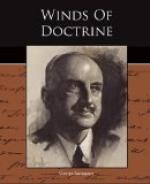These are but gusts of doctrine; yet they prove that the spirit is not dead in the lull between its seasons of steady blowing. Who knows which of them may not gather force presently and carry the mind of the coming age steadily before it?
II
MODERNISM AND CHRISTIANITY
Prevalent winds of doctrine must needs penetrate at last into the cloister. Social instability and moral confusion, reconstructions of history and efforts after reform, are things characteristic of the present age; and under the name of modernism they have made their appearance even in that institution which is constitutionally the most stable, of most explicit mind, least inclined to revise its collective memory or established usages—I mean the Catholic church. Even after this church was constituted by the fusion of many influences and by the gradual exclusion of those heresies—some of them older than explicit orthodoxy—which seemed to misrepresent its implications or spirit, there still remained an inevitable propensity among Catholics to share the moods of their respective ages and countries, and to reconcile them if possible with their professed faith. Often these cross influences were so strong that the profession of faith was changed frankly to suit them, and Catholicism was openly abandoned; but even where this did not occur we may detect in the Catholic minds of each age some strange conjunctions and compromises with the Zeitgeist. Thus the morality of chivalry and war, the ideals of foppishness and honour, have been long maintained side by side




